Your source for the latest news on yachts, boats and more. Read through our articles to find out how to compare boats and find the right fit for you!

[Updated] The fastest cruising catamarans of 2020
Jun 26, 2020
less than a min
![fastest cruising catamaran [Updated] The fastest cruising catamarans of 2020](https://blog.theboatapp.com/_next/image?url=https%3A%2F%2Fmdc-strapi-cms.s3.eu-central-1.amazonaws.com%2Ffastest_cruising_catamarans_2020_09f12671f1.jpg&w=3840&q=75)
Catamarans are some of the most interesting boats to roam the oceans. They are not only considered great looking vessels with plenty of space for utmost comfort, but also fast boats that you can use in races. Performance catamarans are categorized as multihulls and offer unique design features in addition to unparalleled speed.
Several lists have been compiled to categorize the best catamarans every year. Here are some of the fastest cruising catamarans of 2020 :
- Outremer Catamarans have made a name for themselves for being fast as well as fun. With the Outremer 45 as a wonderful representative, these catamarans are characterized by narrow bows and large rigs. The Outremer 45 features a smart design from Barreau-Neuman, constructed in the Outremer yard in the South of France. It is built in carbon, glass, vinylester and divinycell in order to be durable and strong. This boat can reach a maximum speed of 15 knots, with a comfortable sailing speed at 9-10 knots.
- The Privilege Signature 510 is another fast cruising catamaran, recently acquired by the German Hanse Group. It is an elegant and sportive design with an arched coach roof. It features a galley, a living area, a carbon mast, and a very appealing exterior. This catamaran costs 995,000 euros.
- The Marsaudon Composites ORC50 also makes this list. What is unique about these vessels is that they can be used for racing as well as cruising. Designed by Christophe Barreau, this boat features a sporty look with an angular coachroof, large inverted bows, a powerful rotating carbon mast, and a high freeboard. In addition, the ORC50 is a lightweight boat that allows it to gain speed quite easily.
- Next in line are the Fountaine Pajot yachts. These boats present a good balance between comfort and performance, which has been what boat owners and mariners have been looking for lately. Most of their boats are able to sail at 9-10 knots with less resistance, while still maintaining a smooth voyage for the crew. Some of the fastest cruisers from Fountaine Pajot include Astréa 42 and Elba 45 .
- Last but not least, the Gunboat 68 is a lightweight boat that is suitable for many sailing conditions. This multihull sailboat has high-aspect straight daggerboards, strong bows that manage to cut through waves, and retractable rudders. It also features different layouts that can house 4, 5, or even 6 cabins. The interior of the boat is a pure reflection of the external shape of the hull. All in all, this is an ergonomic design that aims to be flexible and easy to use by anyone on board. This catamaran costs 5.5 million euros.
These are the top five fastest cruising catamarans of 2020 according to us . Other impressive cruising multihulls include the Dolphin 42, Privilege 435, Fountaine Pajot Belize 43, Nautitech 44, Lagoon 440, Voyage 44, Outremer 45, Prout 45, and Leopard 45. Explore their features and more catamaran characteristics, keeping also a full record and management of your boating life with TheBoatAPP .
You might like these too

Electric and Hybrid Boats – The Future of Sailing lg ...
Aug 23, 2022
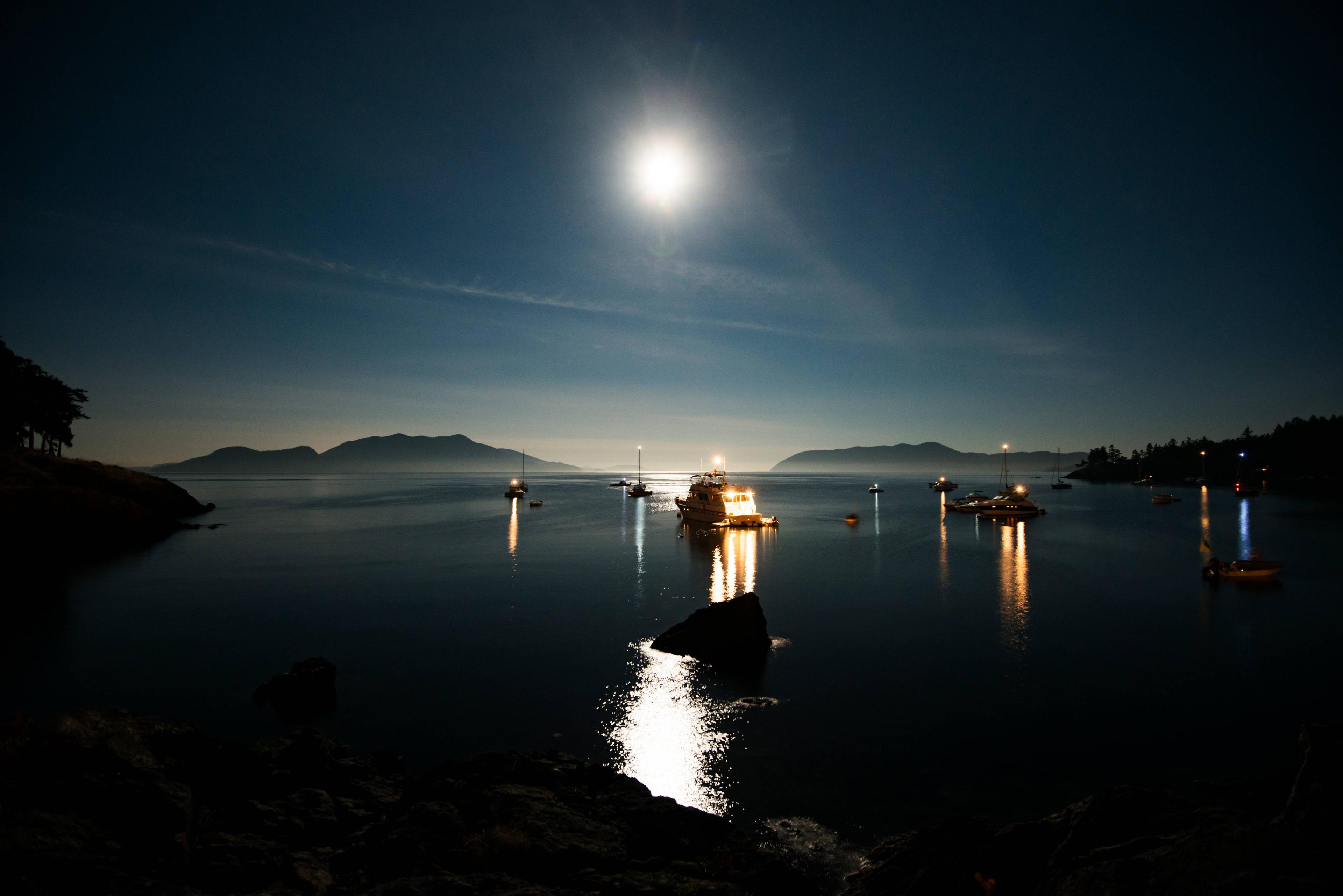
Boat navigation light types and functions lg ...

How Long does it Take to Sail Around the World lg ...
Oct 04, 2021
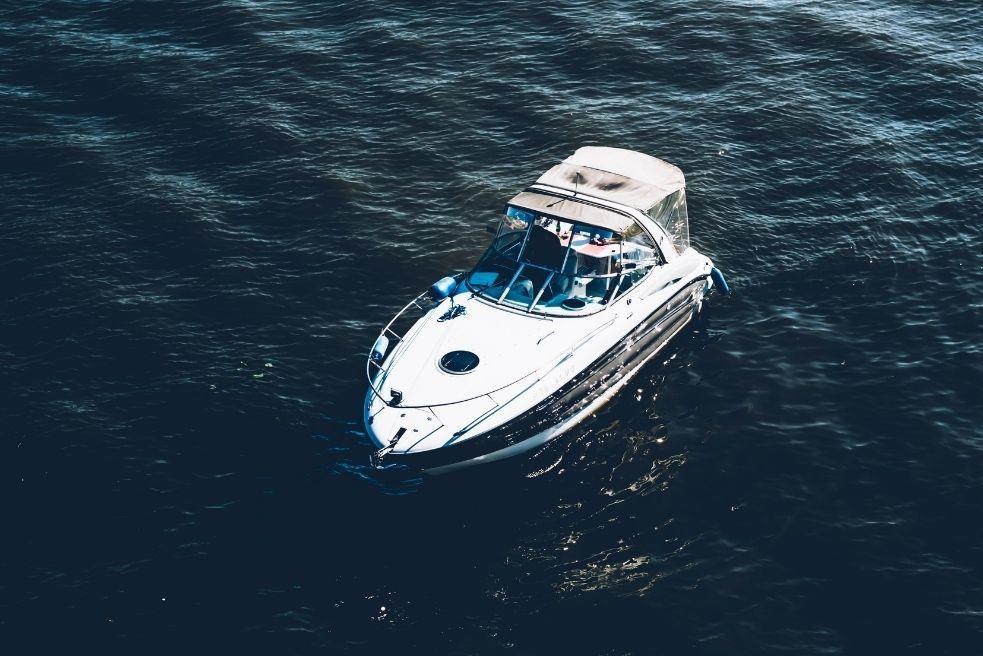
What are some Fun Things to Bring on a Boat lg ...
Oct 01, 2021
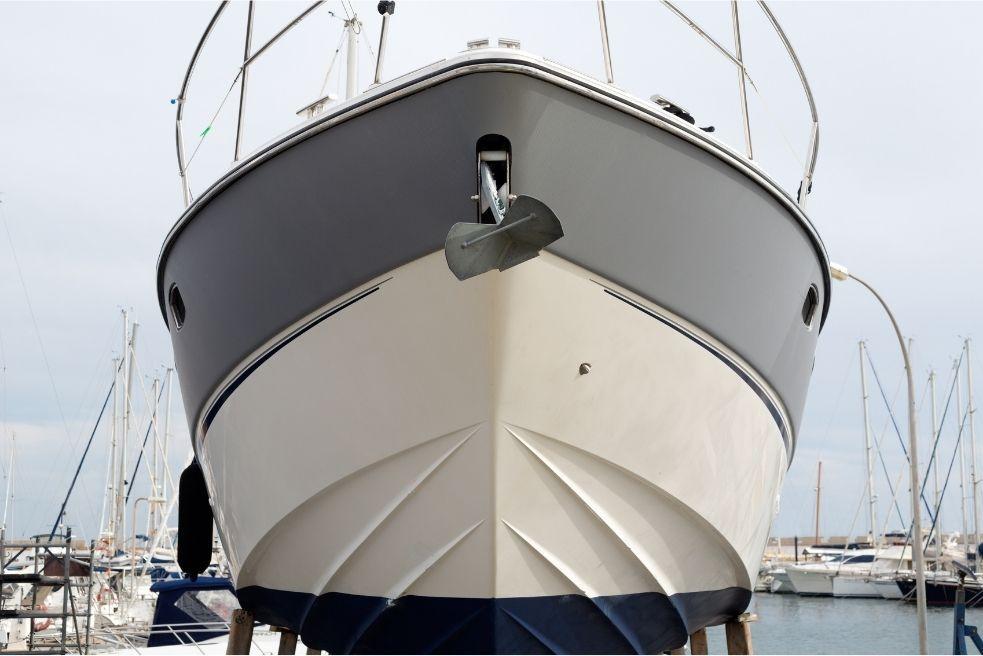
The Proper Term for the Forward End of a Boat lg ...
Sep 30, 2021
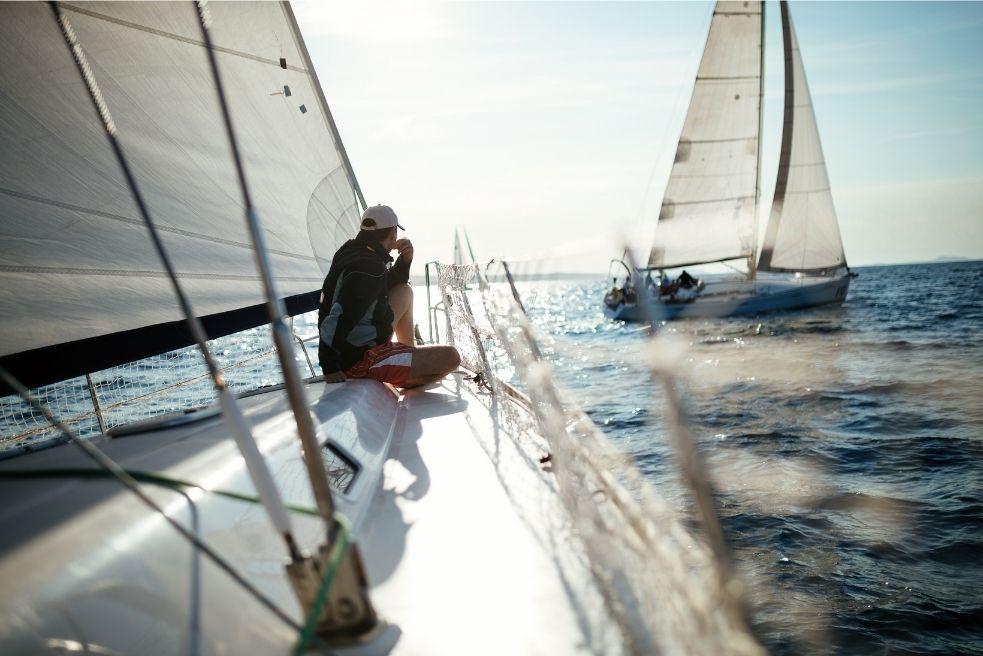
Regular Boat Maintenance Tasks You Should Always Do lg ...
Sep 17, 2021
- Yachting for beginners
- Owning a yacht
- Motor Yachts
- Sailing Yacht
- Indian Ocean
- Mediterranean
- Buying or Selling a Yacht
- Yachting Events
- FAQ – Luxury Yacht Charter
- FAQ – Buying a Yacht
- FAQ – Sell your Yacht
- How Much Does It Cost To Charter A Luxury Yacht?
- All our Blog Post & News

What are the Fastest Cruising Catamaran on the Market?
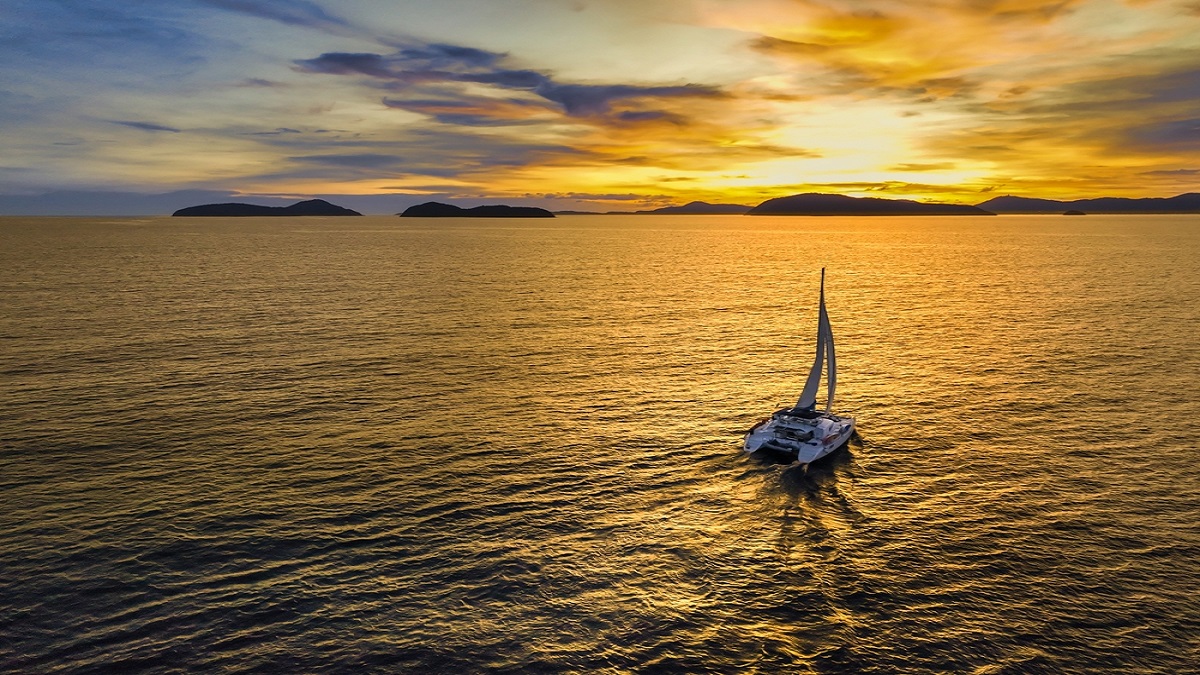
For those who love the thrill of the open sea, speed is an essential element of their sailing experience. For years, catamarans have been a top choice for sailors who want to explore while enjoying the benefits of speed, comfort , and luxury. In recent years, the trend towards high-end fast catamarans has exploded. If you are looking for speed combined with affordable luxury, look no further than the fastest catamarans on the market.
How fast can cruising catamarans usually go?
Cruising catamarans can reach speeds that can exceed their respective theoretical hull speed thanks to their light weight, generous amounts of sail area, and minimized wetted surface area. It is not uncommon for them to reach sailing speeds of 30 knots or more. They can also offer better stability than a monohull, making them an ideal choice for long ocean passages.
What Makes the Fastest Catamarans on the Market more Rapid Than the Others?

When it comes to catamarans, Gunboat is a brand that stands out from the crowd. Known for their exceptional quality, performance, and luxurious design, Gunboat delivers a unique sailing experience that has captivated the attention of sailors around the world. Their latest offerings – the Gunboat 68, 72V, and 80 – are perfect examples of the brand’s commitment to delivering top-of-the-line sailing yachts that offer the best of both worlds: the performances of a racer in a luxury cruiser catamaran.
The Gunboat 68 is a spacious and comfortable yacht that boasts an internal helm station and sophisticated lounging areas. With room for up to six cabins, including a spacious master, and a forward cockpit, the Gunboat 68 offers everything that sailors could ask for in a luxury catamaran. But don’t be fooled by its luxurious design – the Gunboat 68 also offers exceptional performance, making it a true racer’s yacht.
The Gunboat 80 takes everything that sailors loved about the Gunboat 68 and ramps it up to the next level, with even more space and more advanced features. Designed for sailors who demand the very best, the Gunboat 80 offers a cruising experience like no other. And as with all Gunboat yachts, performance is at the forefront of its design. Expect nothing less than exceptional sailing speeds and adrenaline-pumping races.
But perhaps the most exciting development in the Gunboat lineup is the new 72V. This unique yacht is a bit of a gamble for the brand as it features a flybridge. But don’t think that this will make it any less of a racer – the 72V is designed to be streamlined compared to traditional production catamarans, and it still offers exceptional speed and performance. And with a flybridge helm station, sailors can look forward to even more control and a truly immersive sailing experience.
“Cruisers do not understand the massive difference between a racer and cruiser, with tremendous emphasis on weight and performance.” Gunboat understands that difference all too well, and their commitment to pushing the limits of what is possible with luxury cruiser catamarans is what sets them apart. Gunboat is leading the way in the world of high-performance luxury sailing, and they show no signs of slowing down any time soon.
Read also: INTRODUCING THE NEW GUNBOAT 72V “WONDERFUL”: THE ULTIMATE FLYBRIDGE CATAMARAN
HH Catamarans
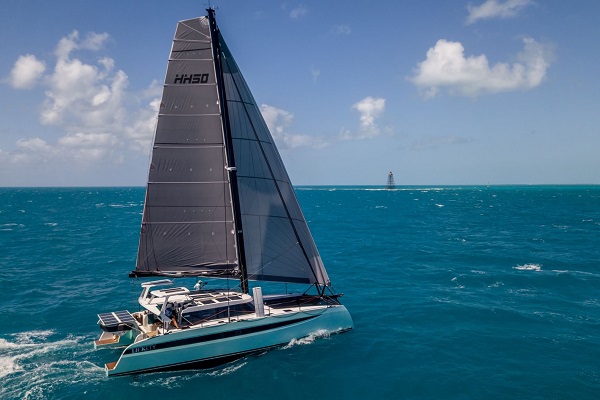
HH Catamarans may be a relatively new player in the world of high-performance cruising yachts, but they have quickly risen to become one of the most respected names in the industry. Built in Xiamen, China, by the same contractor that once had built Gunboats, HH Catamarans are designed to offer an unparalleled level of luxury combined with the ultimate sailing performance.
When HH Catamarans emerged in the market a decade ago, they had to make a crucial decision about what kind of boat they wanted to create. Ultimately, they decided to prioritize speed and performance over everything else, a decision that has drawn praise from seasoned sailors. Their boats range from 44ft to 88ft in length, all featuring exceptional craftsmanship and engineering.
One of the crucial features on HH Catamarans is their hydraulics and smart deck planning. Combined with their captive winches, these features allow sailors to get the boat off the mooring, sails up, and cruising at speeds up to 20 knots in just four minutes. This level of speed and agility is unparalleled in the world of cruising catamarans.
In addition to their performance and speed, HH Catamarans boast quality construction that makes them the strongest yachts possible without adding significant weight. Carbon and epoxy are used to create the strongest possible hull, while all lines run under-deck to create an uncluttered walkway. The stanchions are also a generous 900mm tall, providing necessary safety when sailing with friends and family. The continuous, unbroken toe rail runs the length of the deck, enhancing the boat’s aesthetics while keeping the structure stable.
Overall, HH Catamarans has carved out its niche in the ultra-luxury sailing market, offering high-performance cruising catamarans that deliver both speed and comfort in equal measure. Every detail has been carefully thought out, from the construction of the hull to the onboard technology and smart deck planning, delivering an unparalleled sailing experience for those who want to push their yachts to the limit.
The Kinetics Catamaran’s Unmatched Velocity and Beyond
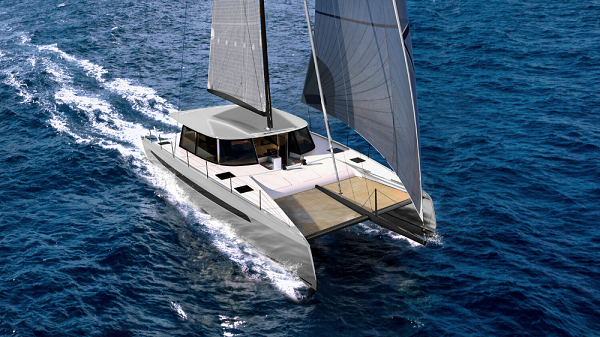
Founded in 2018, Kinetic Catamarans is a US company based in Knysna, South Africa. Their team consists of Bob Hayward, a successful US real estate developer, co-founder of Summit Entertainment, and farmer, and Leon Scheepers, a highly respected South African boatbuilder with extensive expertise in multihull production. Both share a deep love for sailing and a strong commitment to improving the boating industry.
Their main goal is to build luxury performance cruising catamarans of the highest caliber. In 2021, they proudly achieved this goal when the KC54 received prestigious accolades shortly after its launch. The Cruising World Magazine awarded it the Boat of the Year in the Judges Special Recognition category, and it was also named the Best Large Multihull (50ft and above) by SAIL Magazine.
Nevertheless, Kinetic Catamarans has been making waves in the boating industry with their luxury performance cruising catamarans, and their latest model, the KC62 , takes their offerings to a whole new level. This vessel boasts unmatched velocity and beyond and is a testament to the dedication and expertise of the Kinetic team.
One of the standout features of the KC62 is its lightweight design. The use of chemically-strengthened glass for the 360° windows, combined with other weight-saving measures, has resulted in a vessel that is both faster and more fuel-efficient than other catamarans in its class. In fact, the KC62 has been clocked at speeds of up to 30 knots!
But this vessel isn’t just about speed. It also offers unmatched comfort and luxury for its passengers. The spacious double cabins are outfitted with abundant clothing storage and en-suite bathrooms, while the saloons provide a cozy space for relaxing and socializing. The use of designer tables and stools and the latest appliances adds a touch of elegance to an already luxurious experience.
While the KC62 shares many of the features of other Kinetic catamarans, it also has its own unique touches that set it apart. For example, the vessel has two helm stations on each quarter and another one inside, as well as a forward cockpit that doubles as a leisure zone. This forward cockpit provides a cool and breezy spot for passengers to relax and take in the stunning scenery.
All of Kinetic’s vessels are designed by the highly experienced and innovative Simonis Voogd Design BV, and the KC62 is no exception. This vessel is a testament to the collaborative effort of a team dedicated to creating the highest quality, most luxurious catamarans on the water today.
Conclusion:
The market for fast cruiser catamarans is growing, with more brands and models being developed each year. These catamarans offer high performance, stability, and luxury, making them an ideal choice for adventurous sailors who want to explore the world in style. While the fastest catamarans on the market may come with a hefty price tag, the experience of sailing on one of these vessels is second to none. With their impressive speeds and luxurious amenities, it is no surprise that more and more sailors are turning to fast cruiser catamarans for their next adventure on the water.
Read also: 9 catamarans for sale under 5 millions
Predator 84 for charter: a Review of the Must Try “Alvium”
Where can you sail in march, you might also like.
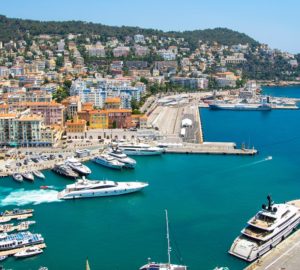
What differentiates a yacht from a superyacht or a mega yacht?
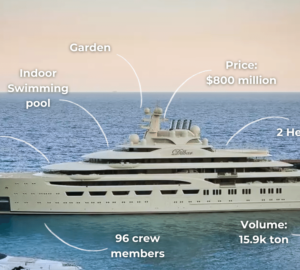
10 Things you’re Wondering about Dilbar Yacht (price, location, owner…)
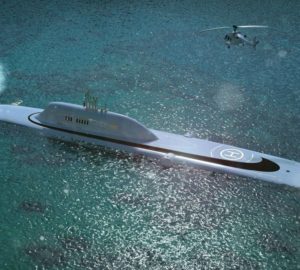
Migaloo: The $2 Billion Superyacht Submarine

Fastest Cruising Sailboats

Last Updated by
Jacob Collier
August 30, 2022
If you're looking to buy a sailboat, getting a cruising sailboat may have crossed your mind. So, what are the fastest cruising sailboats out there?
Like everything else in life, not all sailboats are created equal. Cruising sailboats have a lot to offer if you are looking for a reliable boat that allows you to take a long getaway and is easy to navigate.
Some of the fastest cruising sailboats include the Beneteau Oceanis 30.1, which can travel at 20 knots; the Grand Soleil 34, which touches 20 knots; and the Italia 9.98, which can reach up to 40 knots. Of course, there are many other high-speed cruising sailboats that you can choose from.
If you love to cruise but still want to reach your destination fast, then a fast cruising sailboat will be your best option. After asking many sailing experts and cruising sailboat owners, we finally have the skinny on the fastest cruising sailboats.
As avid watersports enthusiasts and sailboat owners, we can help guide you through the process of choosing between some of the fastest cruising sailboats in the world.
Table of contents
Fastest Cruising Sailboats
The boat you buy should be influenced by your local waters or where you plan to travel. Because many portions of the coastline are exposed to the ocean, if our coastal cruising grounds were in New England, we’d want our boat to be able to manage offshore conditions Due to the logs and debris floating about in the Pacific Northwest, we’d want a sturdy rudderpost and a shielded prop; a tall rig would be a godsend in the light airs that are common during summer. It would be pointless to buy a boat without a centerboard if I lived near the Florida Keys.
Because her cruising gear makes up lesser of the overall displacement than a bluewater liveaboard yacht, a coastal boat can be a relatively light design. However, going offshore does not require sacrificing sailing performance. The classic Valiant 40 by Bob Perry is a wonderful example. Its low displacement, strong sailing ability, and comfortable layout make it an excellent candidate for long-distance cruising; many other recent designs are the same.
Italia 9.98
Italia Yachts created the Italia 9.98 Fuoriserie, which won the ORC - C - 2015 World Championship. She is a racing yacht that may also be used for cruising. However, the design is intended to race and win, and the mast and boom are composed of carbon fiber. The interior features include two double bedrooms, two sleepers in the saloon, a kitchen, and a chart table.
The 34-foot Italia 9.98 was clearly the most striking of the five boats that made up the Performance Cruiser class in terms of pure look. The boat comes in two versions: the 34 Club, designed for cruising and is distinguished by its twin wheels, and the 34 Fuoriserie, designed for racing.
Both versions have the same interior, which is extremely welcoming and modern for cruising. A wide trimmed in a teak cutaway that can also be used as a ring frame lead to the spacious double-berth forward, which virtually beckons you to climb in and kick far back. The drop-leaf table, crossed by the keel-stepped spar, is flanked by two huge center settees.
The galley and the navigation station, located to port and starboard, are welcome surprises. The galley contains a huge fridge and a two-burner stove gimballed, while the navigation station is bigger than you could anticipate for a boat this size.
Innovative, detachable cloth lockers may be offloaded while in race mode. Cabin doors encased in metal for durability are among the many appealing touches to this vessel. There's a large double stateroom to port and a tiny double cabin to starboard. Except for some teak trim, all furnishings and fixtures are sleek, white composite constructions that appear more aeronautical than nautical. Overall, the entire design and aesthetics are very nice and contemporary.
The cockpit is roomy on the inside; the molded-in bench seats may be enlarged with specialized storage bins, which can be left at the dock for racing and reinstalled when cruising. A large lazarette locker is located aft of the beam-width traveler, which is located aft of the tiller.
The open transom gives the impression of being aboard a larger boat. The German-style double-ended mainsheet is led below deck, adding to the modern motif; sheet leads are, of course, changeable. The genuinely exceptional nonskid is molded into the deck.
The boat has an optional sprit that could be used to fly, reaching, and off-wind sails. Another version of the sprit incorporates an anchor roller; the boat we were on did not have a windlass, but one is available. It would be simple to adapt this boat from racing to cruising mode.
The Grand Soleil 34
When the Italian boatyard Grand Soleil was established in the 1970s, its first model was a 34-footer designed by Finot. It was an instant success, with over 300 units sold. It set the firm on the path to success that lasted decades, mainly with a succession of considerably bigger, more complicated racer/cruisers. The maker opted to go back to its origins with the Grand Soleil 34 for 2020, and it's a fantastic boat.
There are a few key rating criteria that racing boats compete under these days, plus a rising movement of doublehanded classes in several major regattas. Since conditions vary dramatically depending on where you plan to sail, the Grand Soleil 34 doubles as a cruiser. The need for a versatile vessel has been taken into account by Grand Soleil and is evident in its exquisite design. The Grand Soleil 34 does this by offering a variety of keel, rig, and deck options, allowing owners to tailor their boat to their specific location or events.
The shallower of the two keel choices, which is also the ideal cruising configuration, draws under 6 feet and is equipped with a lead bulb; a deeper 7-foot-2-inch foil is also available. A conventional aluminum stick or one of two alternative carbon spars are available as rig options. The boat has dual rudders and wheels, but you can alternatively have a single rudder with a tiller. The power unit on our variant was a 20 hp diesel with saildrive, which was an option. The boat design has the optional 30 hp diesel with saildrive, with a 20 hp auxiliary as standard.
The accommodations are essentially the same regardless of the performance package you choose. You still have options, though. In cruising mode, the open layout features a wide double berth in the bow, but while racing, you can remove the cushions and their base to transform the area into massive sail stowage. For competitive sailors concerned with keeping weight to a minimum, most of the oak furnishings and floors may be replaced with composite materials or even carbon.
A pair of settees flank a drop-leaf table in the middle of the boat, and there's a wide double cabin aft, to port, and a capacious head on the opposite starboard side, via which you can reach a large storage compartment beneath the cockpit seat. The great news is that there is also plenty of storage space for sailing.
Impression 45.1
The Elan Impression 45.1 now features a longer and broader cockpit, defined by dual wheels, a split cockpit table, and a folding sunbed, as inspired by the Elan GT5. A contemporary vertical transom was built, and two big cockpit storage boxes that may be furnished with a grill, sink, or refrigerator. Because of its hull design and recognizable deck saloon windows, the Impression 45.1 is light and airy. The saloon has a big settee that completely surrounds the table without blocking the path.
The galley has been moved forward to provide greater space for living and navigation. You also get solid iroko wood for the interior furniture material after months of testing because it was discovered to have the best endurance characteristics, a lovely traditional aesthetic, and an acceptable pricing point. The Elan Impression 45.1 will be offered with two cabin configurations, one for friends and family and the other for demanding charter parties.
Customers may now select between an open transom for a sportier look and a closed transom with a wide swim platform for safety and comfort. One of the more noticeable improvements is a new window, which illuminates the back cabins and adds to her instantly identifiable appearance.
It's no wonder that many would-be bluewater cruisers have this German Frers design on their wish list. The hull is well-built, featuring a sturdy masthead sloop sail plan—200-mile days are not out of the question—and the deck arrangement is ergonomically efficient. Belowdecks, no two boats are alike, thanks to the builders' willingness to experiment with layout and finish. The RS (Raised saloon) model expands on the already spacious interior. The new Hylas 56 has a similar streamlined hull. It is no wonder that its owners praise the boat's seakeeping and maneuverability.
With the Atlantic Rally for Cruisers, more Lagoons than any other brand of a catamaran have crossed
the Atlantic and more 440s have participated than any other Lagoon. It's simple to understand why
this yacht is so popular among visitors visiting the tropics. The saloon, the spacious cockpit, the broad trampoline forward, and the flybridge provide plenty of opportunities for the crew to have quiet time on passage or assemble for meals and socialize in port. The 440 is not a Sportster when it comes to
sailing, but it is capable of decent trip times while keeping its crew safe and comfortable.
The Meta 50' is a strong and comfortable long-distance cruising sailing yacht. This beachable twin-keel offshore sailing yacht has a 1.80m draught, lovely sunbathing places, and a garage big enough to fit the semi-rigid tender with an outboard motor.
This enormous sailing boat has two double bedrooms in the back, a spacious saloon with an open kitchen and panoramic views, a chart table, a bathroom, and a large owner's stateroom with a dressing room and separate bathroom. In the forepeak, a skipper's cabin with an attached bathroom is also available, which is just one of the many comforts on the Meta.
The Meta 50' is constructed of ultra-resistant prestressed Strongall aluminum and may be customized to meet your exact requirements. Thanks to the ballastable dual keel system, the TurboKeels version will have performance comparable to a 3.50m draught keelboat while simultaneously reducing the list by 15-20°.
Domani introduces the S30, a one-of-a-kind sailing experience that combines sportiness, elegance, and design in a single exquisite sports boat. Less is more, and free time is valuable; that is what you get with this cruiser. The design also uses a back-to-basics approach, with fewer components and less upkeep. It's all about disconnecting from shore power and sailing away in minutes. With electronic sail propulsion, it's light and green, and its manageable size makes it easy to carry or store.
Summer in the Fjords is unlike any other, as is summer in St Tropez. Explore new beaches and seas, meet new people, and expand your sailing horizons beyond the neighborhood harbor. Isn't it true that the goal of every journey is to learn something new? It is easy to see what the brand is all about. The Domani is about Gran Turismo-style sailing: quick, exciting, and elegant.
The Beneteau Oceanis 30.1
The Beneteau Oceanis 30.1, a 31-foot-3-inch tiny yacht that was best-equipped and spec'd out as a specialized cruising boat, was also given the title of Best Performance Cruiser for 2020. But don't be fooled by her modest internal amenities; she is a lively small ship.
The sail layout emphasizes power aloft with a single-spreader fractional number rig with a square-top main. Our test boat has an optional bowsprit and a lap-streak genoa; the normal version features a self-tacking 100 percent headsail. Although dual wheels make handling straightforward, old-school men (like me) can choose a tiller.
A boarding ladder and a small fold-down boarding step are included on the transom. Also, a Facnor headsail furler is stationed alongside the Lewmar windlass on the opposite end. The overall level of attention to detail is outstanding.
The adaptability of the 30.1 was a strong selling point for the judging panel. There are four keel variations, as well as a centerboard. A tabernacle may be added to the deck-stepped mast for simple lowering and trailering to a new location or navigating waterways. It was also the most affordable option in the category, at $160,000. The benefits just kept on coming.
The forward V-berth is undoubtedly spectacular, and the deck-stepped spar described before freed up the space below, especially in the center saloon and eating area. The entire galley is to port at the foot of the companionway, and the enclosed head is to starboard, where there is also a practical tiny navigation station. A large aft double cabin may also be found to starboard. This is an ideal solution for a small family or a couple of couples.
There's plenty of natural light below deck thanks to the coachroof windows, and overhead hatches, which are supplemented by energy-efficient LED lighting. The eye-catching hull decorations grab attention, and the well-executed dodger is an excellent spot to get out of the rain.
Related Articles
What Is A Cruising Sailboat?
5 Best Cruising Sailboats In 2024
What To Look For In A Cruising Sailboat
Born into a family of sailing enthusiasts, words like “ballast” and “jibing” were often a part of dinner conversations. These days Jacob sails a Hallberg-Rassy 44, having covered almost 6000 NM. While he’s made several voyages, his favorite one is the trip from California to Hawaii as it was his first fully independent voyage.
by this author
Best Sailboats
Most Recent

What Does "Sailing By The Lee" Mean?
Daniel Wade
October 3, 2023

The Best Sailing Schools And Programs: Reviews & Ratings
September 26, 2023
Important Legal Info
Lifeofsailing.com is a participant in the Amazon Services LLC Associates Program, an affiliate advertising program designed to provide a means for sites to earn advertising fees by advertising and linking to Amazon. This site also participates in other affiliate programs and is compensated for referring traffic and business to these companies.
Similar Posts

Affordable Sailboats You Can Build at Home
September 13, 2023

Best Small Sailboats With Standing Headroom
December 28, 2023

Best Bluewater Sailboats Under $50K
Popular posts.


Best Liveaboard Catamaran Sailboats

Can a Novice Sail Around the World?
Elizabeth O'Malley
June 15, 2022

4 Best Electric Outboard Motors

How Long Did It Take The Vikings To Sail To England?

10 Best Sailboat Brands (And Why)
December 20, 2023

7 Best Places To Liveaboard A Sailboat
Get the best sailing content.
Top Rated Posts
Lifeofsailing.com is a participant in the Amazon Services LLC Associates Program, an affiliate advertising program designed to provide a means for sites to earn advertising fees by advertising and linking to Amazon. This site also participates in other affiliate programs and is compensated for referring traffic and business to these companies. (866) 342-SAIL
© 2024 Life of Sailing Email: [email protected] Address: 11816 Inwood Rd #3024 Dallas, TX 75244 Disclaimer Privacy Policy

My Cruiser Life Magazine
Sailing Catamaran Speed
You’ve probably heard that one of the best reasons to get a catamaran is because they’re fast. After all, there’s a race any time there are two sailboats on the same waterway.
But like all things in boating, speed is a relative term. Catamarans seem fast to those coming from slow and heavy monohull sailboats, but cruising catamarans are still pretty slow vessels. There are indeed high-tech racing catamarans breaking speed records all the time. Still, the vessels that most liveaboard cruisers venture out on are only slightly faster than their monohull counterparts.
For this article, we will look at the types of catamarans people live on and cruise on. Forget about those fantastic America’s Cup yachts or those multihull go-fast fishing boats for a few minutes.
I have had experience cruising and living aboard both catamarans and monohulls. For five years, my wife and I enjoyed catamaran sailing on a Lagoon 380. We then switched—for many reasons—to a Cabo Rico 38. The Cabo Rico is a traditionally-designed monohull with a full keel and a heavy displacement. In other words, it’s about as far away from a “speedy” catamaran as one can get.
Table of Contents
How fast can a catamaran go, measuring catamaran speed, catamaran speeds vs monohull speeds, sailing cruising catamarans, performance cruising catamarans, racing catamarans, power cruising catamarans, catamaran top speed, faqs – how fast are catamarans.
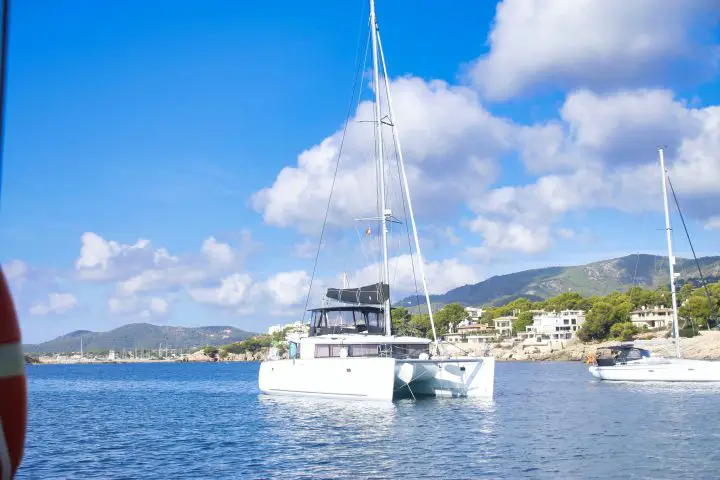
There’s no doubt that catamarans are some of the fastest sailboats around—but there’s also a lot of misinformation and misunderstanding online about how fast they really are.
Realize that not all catamarans are created equally. There are cruising catamarans built to carry their passengers in comfort. And then there are racing catamarans built for nothing but speed. Somewhere in between, there is a poorly-defined category of “performance cruising” catamarans that stir passions.
So, are catamarans fast? Well, it’s all relative. But, if you compare them to monohull sailboats of similar sizes and capabilities, the catamarans are usually faster for several reasons.
The speed difference is even harder to measure in the cruising catamaran category. One of the reasons catamarans beat monohulls during races is because they are built light with no ballast. But a heavily-laden cruising cat ready for an ocean crossing is hardly “lightly loaded.” Will it still beat a similarly heavily-laden monohull? Sure! But probably not by as much as you might think.
Boats measure their speed in knots. Traditionally, this was measured by a tool known as a knot log. The modern equivalent is an underwater instrument with a spinning wheel that effectively measures the speed of the water passing over the hull. So long as no currents are present, that speed will equal the boat’s speed over the ground (SOG).
Satellite navigation allows us to measure our SOG more accurately, but this isn’t a great indication of boat performance since it will be affected by tides and ocean currents.
For landlubbers, one knot is equal to about 1.15 statute miles. So, in other words, when we say that a sailboat cruises at 6 knots, it means it’s going about 7 mph.
But before going any further, consider this—the maximum speed that a sailboat makes is generally a pretty meaningless number. Maybe the knot log pegs to 13 knots for a few seconds, thanks to a strong gust of wind while you’re headed down a large swell. Does this mean you’re driving a 13-knot boat?
A voyaging sailor who has made a long passage will have little interest in this sort of number. When you’re crossing oceans, what really matters is how many miles pass under the keel each day. The more miles you tick off, the shorter the passage. So most sailors learn quickly to look past the “fastest speed in knots” number and find real-world stats on passage miles.
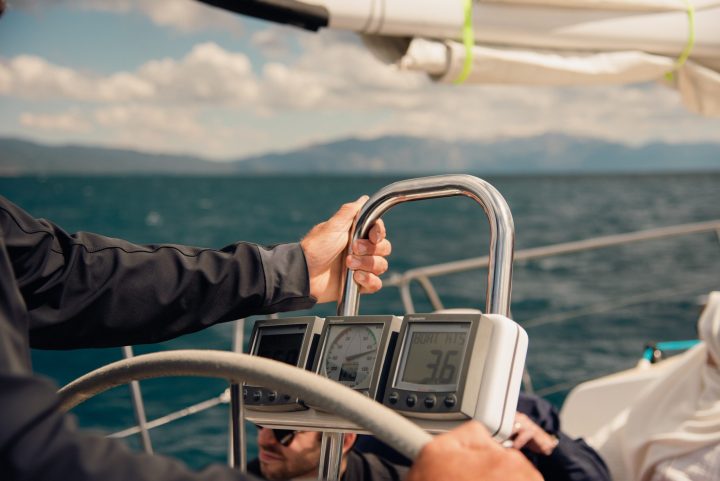
Comparing speeds between radically different sailing vessel hulls is like comparing apples to oranges. Even seemingly similar boats, like “cruising sailboats,” the differences between one and the other are endless.
For example, let’s say you wanted to compare 38-foot monohulls to 38-foot catamarans. The speed of a monohull is limited by waterline length, which means you’d have to look at a hull that is significantly more than 38 feet in most cases. On the other hand, the catamaran is known for long swim platforms on inverse transoms and plumb bows—meaning most 38 foot cats have nearly 38 feet of waterline.
Then, what sort of hull design makes a fair comparison to a catamaran? Would it make sense to compare a transitional, salty 38-footer with a full keel? Probably not. Most sailors interested in the cruising catamaran lifestyle would more than likely be comparing it to a modern monohull with a flatter bottom, fin keel, and spade rudder.
What about the catamaran? There’s a lot of variation in the catamaran field regarding performance. If speed is your goal, you likely want to compare the high-end performance brands—Outremer, Gunboat, HH, and the like. These boats are becoming more popular, but most cruising cats you see on the water are not performance models. Instead, they are the big and comfortable cruisers made by Lagoon, Leopard, or Fountaine Pajot.
Finally, how can you fairly compare the stats? Boats sail differently in different wind speeds and at different points of sail. In other words—there are a lot of variables that make it hard to answer the question, “How fast can a catamaran go?”
Polar charts for each vessel can provide some clues to make a somewhat fair comparison. Polar charts are graphical plots of a sailboat’s performance in different wind conditions and at different points of sail. Manufacturers seldom publish since no two are ever perfectly alike. They are less of a boat specification and more of one sailor’s results for a particular boat. Most owners make their own polar diagrams, but they’re still a tool for those looking to get an idea of a model’s performance in the real world.
Speeds of Various Types of Sailing Catamarans
There are several distinct catamaran classes, and predicting speed means understanding what the designers were building the craft to do. You might be surprised to learn that the first “modern” catamarans popped up in the New England racing circles in the late 1800s. Nat Herreshoff’s Amaryllis is particularly famous from the time .
Since then, catamarans have been synonymous with speed. But in today’s world of many different multihull designs, it’s important to set your expectations accordingly. As you would not buy a Ferrari for its cargo space, don’t expect your minivan to win any races at the track.
Examples of cruising cats include popular models made by the big-three catamaran makers—Lagoon, Fountaine Pajot, and Leopard. However, there are dozens of other companies making these boats. The market and industry for cruising catamarans have never been larger.
Most of these boats are engineered to provide comfortable accommodations for voyaging. They first became famous as vessels for sail charter holidays, where their huge cockpits and private cabins made them much more popular than the smaller and cramped monohull options.
As a result, they’re not built with high-tech components or super lightweight performance rigs. Instead, they’re the catamaran equivalent of a Hunter or a Catalina sailboat—mass-produced on an assembly line. That keeps prices lower than other types of catamarans, but it also means that they’re not winning any races. The makers use traditional layups with end-grain balsa-cored fiberglass to keep costs down. In addition, they usually feature stub fin keels, which are foolproof to sail but will not provide the upwind performance of a lift-making daggerboard.
Still, without ballast and when lightly loaded, cruising catamarans can move. They show their colors in light air when heavy displacement-hulled sailboats usually make their poorest showing. Since these moderate conditions also make for great cruising, these boats can provide a lovely ride in smooth weather.
Cruising catamarans can’t plane or anything, but their narrow hulls create an effect that means they can beat the hull speeds of a similarly sized monohull. Of course, it’s not a precise number since every boat and crew is different, but generally, you could expect speeds to be about one and a half times that of a same-sized monohull.
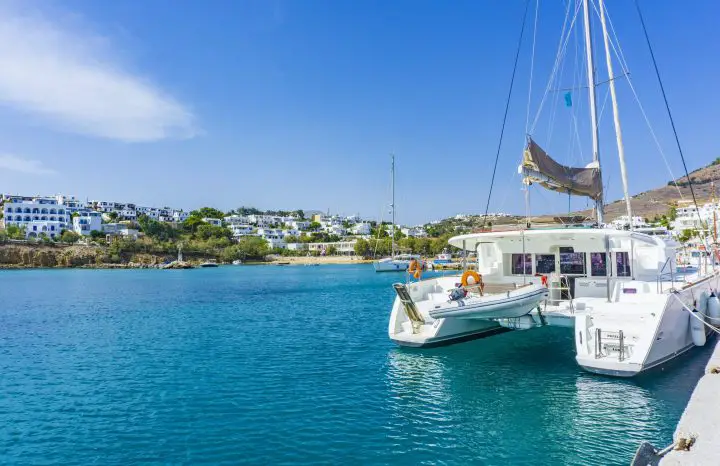
These catamarans are still rigged for comfort, but they’re built using the highest-quality and lightest-weight materials. While their hulls are rigged for comfortable living, they are generally designed much sleeker than regular charter-style cruising catamarans. The hulls are narrower, and you’re unlikely to see tall flybridges or forward lounge seating.
Several companies are making these boats. But in the world of catamarans, a performance cruiser is the upper end of the market. If you want a car comparison, Lagoons are something like a Chevy sedan, whereas an Outremer is like an M-series BMW. A Gunboat would be even more exotic, like a Ferrari. Not only are they more fashionable brands, but they’re also made to higher standards with cutting-edge designs .
It’s also worth noting that the category of “performance cruising cat” is a sliding scale. Some companies make vessels with better materials and craftsmanship than the cruising cats but aren’t designed for speed. Others build cats that are all about performance with few amenities.
With every new model, companies building these cutting-edge boats are attempting to boost the “performance” and the “cruising” aspect of their vessels. As a result, amenities and speed continue to get better and better.
Any racing sailboat is not designed for comfort. Especially on a catamaran, accommodations take up space and weigh the boat down. True racing vessels are designed to not worry about the crew but optimize every element for speed. Once the boat is designed for the desired performance, they’ll squeeze in bunks and storage wherever they can.
As such, there’s not much point in comparing them to liveaboard or cruising sailing vessels—they are too different. Some modern racing catamarans even fly above the water on foils. This makes for a high-speed boat and a considerable risk for sailors traveling for pleasure. Gunboat tried to make a foiling cruising cat in the G4 model, but it didn’t go so well for them.
Power cats run the same gamut of designs that sailing catamarans do. Power catamarans and sport catamarans designs are popular in powerboat circles for the same reasons they are in the sailing world–their hull designs allow for smaller underwater profiles and high speeds. There are many fast catamarans out there with twin engines and average speeds of well over 70 knots. Most recreational vessels cruise at about 20 knots, however.
Power catamarans also offer a smooth ride, making them a popular choice for large vessels like passenger ferries. There are even military vessels that use two hulls, like the stealth M80 Stiletto .
As you can see, catamaran speeds vary from just slightly better than monohulls to extraordinary flying machines. But cats are about much more than just speed. Their open and bright living space makes living aboard an entirely different experience than living on a monohull. Their cockpits flow into their salons for a full-time outdoor living feel that no other type of vessel can match. There are many reasons to choose a catamaran as a liveaboard sailboat.
How fast is a catamaran?
The answer depends on many other questions, like what sort of catamaran is it? And if it’s a sail cat, how fast is the wind blowing?
Sailing catamarans come in all different shapes and sizes. Some are optimized for living space and comfort, while others are designed with fast cruising speeds being the sole goal of the boat. The Gunboat 68, one of the fastest cruising sailboats currently made, can exceed 30 knots.
The world of power cats is much the same. Some power cats can do well over 70 knots, while most cruising boats top out at around 20 knots.
Do catamarans have a hull speed?
A hull speed is a characteristic of traditional displacement-hulled sailing vessels. The properties of the hull shape under the water create drag that limits the overall speed that the vessel can achieve. Even if you keep adding more power (or more wind), the vessel cannot exceed its designed hull speed for any length of time. Hull speed is a factor of waterline length.
Multihulls, however, have an entirely different underwater profile than monohulls. Their narrow hulls and shallow keels mean that drag is not the limiting factor. With this in mind, designers can tweak catamaran hulls to plane and cruise well above the hull speed of a similarly sized monohull.
What is the fastest cruising catamaran?
The market for fast-moving cruising cats has never seen more innovation than in the past decade. This type of boat has taken off, spurred in part by new designs and the overall popularity of multihulls for cruising. The industry leader in fast multihulls is generally considered the French-based company Gunboat . After all, one of the company’s mottos is “Life is too short to sail a slow boat.”
The company’s largest boat to date is the Gunboat 90 Sunshine . However, the delivery of the company’s current flagship, the Gunboat 68 Condor , from France to St. Maarten, provides some real-world numbers. In the delivery crew’s words, “Our max speed exceeded 30 knots a couple of times, and the max 24-hour run was 328 nm.” To save you the math, that works out for an average speed of 13.7 knots for their best day.
Matt has been boating around Florida for over 25 years in everything from small powerboats to large cruising catamarans. He currently lives aboard a 38-foot Cabo Rico sailboat with his wife Lucy and adventure dog Chelsea. Together, they cruise between winters in The Bahamas and summers in the Chesapeake Bay.
- BOAT OF THE YEAR
- Newsletters
- Sailboat Reviews
- Boating Safety
- Sailing Totem
- Charter Resources
- Destinations
- Galley Recipes
- Living Aboard
- Sails and Rigging
- Maintenance
- Best Marine Electronics & Technology
10 Affordable Cruising Catamarans
- By Phil Berman
- Updated: July 9, 2020
So, you want to get a catamaran , sail off into the sunset, and capture some magic with your lover or family for a few years. You have no ambition to sail around the world or to live aboard forever, but think a one- or two-year sabbatical might be life-changing. You’d like to sail the US East Coast, the Bahamas, the Caribbean, perhaps the Med—or up and down the West Coast and on to Mexico and Central America. You have $300,000 or less to spend and want a catamaran you can sell at the end of the journey without consuming a bottle of Tylenol to blunt the pain.
The good news is that this is quite achievable. The bad news is that there is a vast wave of baby boomers who are all looking for the same thing—and for right around the same price. This makes finding a good deal on a great used catamaran a lot of work, even working with a broker. But, it’s possible. You just need to keep an open mind.
The other good news, which might seem surprising, is that an older catamaran, besides being more affordable, might sail just as well—or even better—than the same-size new cat that will cost considerably more. Yes, the older model might have less room inside and lack the latest condo-on-the-water styling, but it was designed and built before the current trend to supersize the newer generations of multihulls at the expense of sailing performance.
Here’s my advice to the cat hunter on a budget: Don’t get too hung up on the length of the boat. Instead, focus on the spatial and payload requirements you seek and which can be achieved within your budget. And best not get too focused on must-have features—what I jokingly call “surround-sound beds.” Catamaran designs and interiors have gone through massive changes in the past 10 to 20 years, and most older designs simply cannot compete with the new ones in terms of space and high-end amenities.
None of the cool cats I have in mind are over 47 feet. This is not because there aren’t bargain boats out there that are 47 feet and longer, but because any larger multihull that you can buy for $300,000 or less will most assuredly need a significant refit or is either very old or very odd. Buying a fixer-upper is, to my mind, the most dangerous thing a budget-minded consumer can do. It’s just too easy to underestimate the cost of yacht refits and repairs due to the extremely high prices charged in most boatyards.
RELATED: 20 Best Cruising and Sailing Destinations
Nearly any cat you buy over 10 years old is fully depreciated. What we were selling a Lagoon 440 for eight or 10 years ago is nearly the same as what they sell for today. The difference between a good deal and a bad deal is tied solely to a yacht’s condition and refit history. As they joke in private-equity circles, “Any idiot can buy; you deserve congratulations only when you sell.”
So, when your search gets underway, focus on condition—it is far more important than the year, brand or features you might crave. And when you find the cat of your dreams, the best way to remove financial-downside risk is to get a great survey and to choose the newest, smallest cat that will work for your agenda, not the oldest and biggest.
And a word of caution: Your problem will be knowing a good deal from a bad one after the survey is over if you are not well-schooled in pricing. Besides steering you toward potential boats to consider, this is where a broker, working on your behalf, can provide knowledgeable advice. It’s been my experience that this is the point when so many yacht sales come apart: a dispute over the value of a given yacht when the survey results come in. All too commonly we see buyers reject yachts they should have accepted and purchase cats they should have rejected. Remember, a used yacht is a used yacht—not a perfect yacht. A catamaran need not be perfect to remain a perfectly good deal. Here, then, are 10 cool cats to consider in the $300,000-or-less range:
1. Fountaine Pajot Orana 44 (above)
Fountaine Pajot had the misfortune of tooling up this boat just before the global financial crisis, so not that many of them were built between 2007 and 2012. But these were the first of the larger-space charter cats in this size, but not yet so porky that they still could not sail decently. In the three-cabin owner’s version, they designed the living space very nicely; even in the four-cabin version, the aft starboard bed was very well-done.
During this period, Fountaine Pajot had problems with the resin it was using, which led to blistering on the hulls and undersides. Affected models therefore had new bottoms done at approved shipyards throughout the world. Make sure the one you are considering had this done or that it doesn’t show evidence of significant blistering. Honestly it is only cosmetic, but it will impact resale if not repaired. Many consumers think blisters are the end of the world; frankly, they are not.
2. Catana 431
Built in France by a long-standing yard, the Catana 431 was always a very viable vessel because it is big enough to go anywhere, but not too large for a competent owner to handle. And because the 431 has good underwing clearance and daggerboards, it sails smartly to windward.
That said, there are a few things to watch for. The primary bulkheads on many of these boats were not tabbed on the outer ends, and over time tended to distort. Often this led, or will lead, to a costly replacement of some bulkheads. So be careful to survey these areas properly.
The 431′s furniture is all foam-cored and handmade, but the banding on the outer edges in some cases slowly starts to peel, which allows moisture to infect the wood veneer. This can create a somewhat unsightly appearance in the cabinets and drawers. It is only a cosmetic issue, but it can make the interior feel a bit worn out.
During the period when the 431 was being built, Catana used a distributive electrical card system, and the boats had several modules, each a zone, to which electricity was run. If one thing in a zone stops working, the only solution is to jury-rig a wire from that nonworking item back to the main breaker panel. Replacing the modules or getting them repaired can be done, but it is getting harder by the year. For this reason, the best 431 is a boat that someone else had rewired at some point along the way.
3. Lagoon 470
If you need a larger escape pod, the Lagoon 470 is one of our favorites. This model of older Lagoons was built at CNB’s yard in Bordeaux, France, and the build quality was high. The 470 was the first design to have the more-vertical windows that are a Lagoon signature, and ample saloon headroom. The 470s are also old enough that the hulls were not so supersize that it compromised sailing performance. They have decent underwing clearance, so they are not persistent pounders to windward. Many were built with a galley-down layout, some in galley-up style. You will always pay more for an owner version of this or any model.
The big thing you have to concern yourself with on Lagoons of this vintage is that the hulls and decks are made with a balsa core, so it is not uncommon to find moisture problems, especially around deck fittings or hatches. This can sometimes require rebedding or recoring areas, and this sort of repair, in North America, can be a costly undertaking. Make sure you get good moisture-meter readings near all deck fittings and, of course, on the hulls. Hulls, however, tend less often to have moisture issues because there are few fittings through which water can enter the core. Were that to happen below the waterline, it is a real mess that must be repaired immediately and properly.
4. Privilège 435
Back when the Privilège 435 was built, Privilège catamarans were constructed by Alliaura Marine in France, and they were truly the Mercedes of the multihull world at that time. While not a performance cat by any means, the 435 was a super-solid yacht, built with great care and the finest components. The 435 is large enough to go anywhere but small enough to handle easily.
The largest negative of this model—and many cats of this vintage—is that the saloon windows slope dramatically, so the interior gets very hot unless the windows are covered most of the time. When they legalize growing pot on catamarans, here’s the perfect greenhouse for it! Seriously, if you should buy a used 435, you really have to get strong sunblocking external UV covers, as well as interior blinds or shades to inhibit heat buildup.
Some of the 435s were laid out with the galley down in one hull, and these days most people want a galley-up arrangement, where cooking and food preparation are done in the saloon. A three-cabin galley-up owner version will be far more sought after and cost more than a four-cabin galley-down version.
5. Leopard 46
This was the first of the Morrelli & Melvin collaborations with South African builder Robertson and Caine and the charter companies owned at the time by TUI Marine to create a catamaran that could be sold both into charter under the Moorings brand and also privately as a Leopard, so effort was made to design a boat with good sailing performance. Gino Morrelli did a good job creating a lot of underwing clearance, the 46 has a powerful rig, and yet its interior still offers spacious sleeping areas and nice flow from the cockpit to the saloon. These can be bought as ex-Moorings charter boats for less than $300,000 but are more costly in the sought-after Leopard owner version.
Because these are balsa-cored boats, you must inspect deck fittings carefully for moisture incursion. Some of the earlier ones also experienced structural problems on the aft bulkhead and over-door-frame areas between saloon and cockpit. Also, during this period, the windows in the main saloon had a tendency to leak and, when they did, required rebedding or replacement. This was a costly job, so check this out carefully during survey.
6. St. Francis 44/Knysna 440
If you wish to spend under $250,000, the older Saint Francis 44 and Knysna 440 are worth a look.
Back in 1990, Duncan Lethbridge started St. Francis Catamarans in South Africa with the St. Francis 43. The boat was meant to be a fast, strong bluewater voyager—and it was. The 43 was made with foam core, keeping the structure light, and it was very strongly built, with a powerful rig. The 43 loved to sail. And so too did the St. Francis 44, an updated version of the original.
The boat did have a couple of negatives, however, the first being its sloped windows that built up interior heat. And the boat wasn’t a great fit for tall people, having less than 6-foot-2-inch headroom in the hulls. Also, the engines were installed amidships, which made the boat noisy inside under power. It also made the amidships areas of the hulls too narrow to have centrally located heads and showers, which in turn meant the only layout available was a four-cabin, four-head design. In the forward cabins, the heads and showers had to be far forward; in the aft cabins, the heads and showers were located far aft.
St. Francis sold the tooling for the 44 to Knysna Yachts in 2004, and Knysna raised the headroom in the saloon and moved the engines aft to each stern. The hulls remained fundamentally the same, but the design was improved nicely.
The largest negative of both the Saint Francis 44 and the Knysna 440 is that they have very low underwing clearance. Things can get pretty noisy when pushing against washing-machine seas.
But you cannot have it all and still pay less than $250,000 in a midsize cat; compromises must be made. And these boats do sail quite smartly compared with many in their size range.
7. Lagoon 440
This was the most popular catamaran ever made, and it started the catamaran flybridge craze, which helped to convert many powerboaters to sailors.
What I like about the 440 is that it is an infinitely better sailer than some of its peers, and has decent underwing clearance, vertical windows, and nice cabins for sleeping and living. While the aft cockpit is rather small, the saloon is quite large.
Flybridges are a bit of a love-hate thing. There is no question that in a cat of this size, the windward performance suffers a bit due to the boom positioned so high off the water. When piloting, the skipper is separated from those on the bridgedeck. Part of the reason flybridges are so popular in charter is that most of the parties take place up there while sailing and at anchor. In private ownership, however, it is seldom that everyone is hanging out on the flybridge during a long passage.
As always with Lagoons, these are balsa-cored boats, so a careful survey is in order. Pay attention also to bulkhead tabbing to make sure they have not separated from the hulls.
Because so many of the 440s were built to go into charter, there are a lot of four-cabin, four-head models for resale. These will sell for considerably less on the brokerage market than a coveted three-cabin, private-owner model.
8. Leopard 40
When you get into the 40-foot size range, a four-cabin layout can become pretty cramped and claustrophobic below, but the three-cabin owner version of the Leopard 40 is a very nice pocket cruiser. A Morrelli & Melvin design, the 40 has good underwing clearance and nicely shaped hulls. Not a large cat, per se, and less-suited for significant distance sailing than others because its payload is limited, the 40 is still well-suited for a couple and a child or two for near-coastal and island-hopping action.
9. Manta 42
If you are searching for a cat in the $200,000 range, the Manta 42s were well-built in Florida, and their electrical systems were very well-done compared with many other multihulls of that era. While many of the features on the boat are quite dated, these Mantas sail very well, and easily, and have been popular with coastal cruisers for two decades.
The largest negative of the Mantas is that people taller than 6 feet will find the saloon headroom right on the edge, and the berths are not especially large. Also, forward visibility from the saloon windows is not particularly panoramic, so the interiors are a bit darker inside than current-generation catamarans.
10. Lagoon 410
The Lagoon 410 was quite a popular cat in its prime, and for good reason. It offers lots of visibility thanks to its vertical windows, good headroom for a cat of its size, nice berths, and a workable, though smallish, galley-up design. The 410 has decent underwing clearance, can sail nicely over the waves, and its singlehanded operation is super easy. In the three-cabin owner’s configuration, it’s just a very cool little cat.
As always, a balsa-core boat must be surveyed carefully, especially on deck, for moisture incursion near fittings and hatches. It can be costly to repair rotted core and to rebed deck fittings. But find a dry one, and it should definitely be counted as a contender for a buyer with a limited budget.
Phil Berman is the president of the Multihull Company and the founder of Balance Catamarans. He has managed the sale of more than 900 catamarans.
- More: catamaran , lagoon , leopard , multihulls , print june july 2020 , Sailboats
- More Sailboats
New to the Fleet: Pegasus Yachts 50
Balance 442 “lasai” set to debut, sailboat review: tartan 455, meet the bali 5.8, route planning in the face of climate change, how to rig everything in your favor, imtra named employee-owned company of the year.
- Digital Edition
- Customer Service
- Privacy Policy
- Email Newsletters
- Cruising World
- Sailing World
- Salt Water Sportsman
- Sport Fishing
- Wakeboarding
- Yachting World
- Digital Edition

Neel 43 on test: Is three the magic number?
- September 17, 2021
Can’t decide between a monohull and a catamaran? The surprising truth is that a fast cruising trimaran, like the Neel 43 could be the ideal solution. Rupert Holmes reports.

Product Overview
Manufacturer:, price as reviewed:.
Until recently it would have been easy to assume the pioneering cruising trimarans of the 1960s and 1970s showed that cruising on three hulls has too many drawbacks to be viable for most, despite the extra space and speed they offered. However, the past decade has seen a resurgence of lightweight fast cruising designs, with spacious accommodation, led by La Rochelle-based yard Neel who recently launched their Neel 43 trimaran.
This latest model, a Marc Lombard-designed 43, is one of those rare boats that defies both expectation and easy classification.
The Neel 43 has the deck space and massive coachroof of the most spacious of cruising catamarans, yet is at least three tonnes lighter than most 42ft cats.

We we tested the Neel 43 in La Rochelle, France with an onshore, 12-16 knot wind with a slight to moderate sea. Photo: by Olivier Blanchet
Another surprise is the low wetted surface area once the windward ama lifts out of the water. Each hull has a narrow waterline beam, so wetted surface area is a fraction of that of a catamaran of similar size. Combined with the light displacement this translates into a boat that’s surprisingly quick.
Neel 43 under sail
After hoisting the mainsail we cut the engine and bore away, unfurling the headsail with the wind on the beam. In only 14 knots of true wind we quickly accelerated to a consistent 10 knots of boat speed.
Sheeting in and squeezing up to a true wind angle of 65° – and 40° apparent wind angle – only saw speed drop by one knot.
Direct Dyneema cables, passing through a minimum of turns, connect the wheel to the single rudder. The helm felt beautifully responsive throughout the test, with a much more direct feel than is generally found on multihulls.

The windward ama lifts easily just out of the water, reducing wetted surface. Stability builds quickly. Photo: by Olivier Blanchet
Tacking proved to be as easy as with a monohull – the boat reliably turned smartly through the wind, with speed rarely dropping much below five knots.
However, visibility from the single raised helm is restricted by the headsail when on starboard tack and by the asymmetric on both tacks.
That there’s a single shallow keel below the centre hull, instead of the two low-profile keels of most catamarans is an important factor in the boat’s handling. It undoubtedly also helps that all the heavy items in the boat, including engine, tankage and batteries, are concentrated low down in the middle of the central hull.
The result is a very comfortable, soft motion that’s easier than that of a typical catamaran, but without the heel of a monohull. In some ways it’s also reminiscent of the easy gait of a heavy displacement long keeler.

The helm felt responsive, with an easy motion. Photo: by Olivier Blanchet
Yet, unlike monohulls, there’s no chance of a broach. Stability builds very quickly after 12-14° of heel is reached, so it takes an enormous force to heel the boat to significantly greater angles. This arguably gives more warning of being overpowered than catamarans, which may generate maximum stability at only 12° of heel.
In addition, the high freeboard means there’s a reassuring amount of reserve buoyancy in the amas, even if the boat is pressed hard in a gust or squall.
On the other hand, a downside of the Neel 43 effectively having a single fin keel is that, unlike most cruising catamarans, it can’t be beached.
Our test boat had standard Dacron sails, so a reasonable set of high-tech sails would undoubtedly see the boat able to squeeze a useful few degrees closer to the breeze without losing too much speed.
Easy motion
However, the reality is that the engine will be used in combination with the mainsail if schedules make a passage to windward essential. Motoring out of the La Rochelle entrance channel head to wind and sea gave a feel for how the easily driven underwater sections behave when motor sailing.
With the single 50hp engine at a comfortable 2,400rpm we made 8 knots, with a gentle motion that didn’t slow the boat.
On turning downwind our speed initially dropped to 6-7 knots at a true wind angle of 150°, until we hoisted the general purpose asymmetric kite. Although it’s not a particularly large sail, this brought the speed back up to 8.5-9 knots, producing our best downwind VMG of 7 knots.

In some ways The Neel 43 sails in a way that is reminiscent of the easy gait of a heavy displacement long keeler. Photo: by Olivier Blanchet
When the breeze picked up a little to 15-16 knots true we sheeted in and luffed up to 115° off the true wind, accelerating to an easy 10.5-11 knots of boat speed. The Neel has so much stability that, even though the sailplan was now generating far more power, there was no perceptible change in heel.
All lines, other than spinnaker sheets, are led to the raised helm station at the front of the starboard side of the cockpit.
Despite its intrinsic speed potential, this is not a boat that’s set up to be constantly tweaked. The deck layout is therefore simple, but efficient. It’s also obviously a cost-effective arrangement, but doesn’t skimp through fitting under-sized winches and other equipment. A powered winch on our test boat took all the effort out of sail handling.
Port and starboard mainsheets – in appropriate colours – give excellent control of the sail shape, without a costly traveller that might endanger the hands of anyone relaxing at the back of the cockpit. The primary sheet is the one on the windward side, while the leeward one gives excellent control of twist.

All lines other than spinnaker sheets are led to the helm station. Photo: by Olivier Blanchet
Headsail sheets are led through a single fixed fairlead. It’s a simple arrangement that minimises coachroof clutter, though twist will increase, spilling wind out of the top of the sail, when it’s partially furled in stronger winds.
Article continues below…

Three hulls, one planet: Neel 51 owner explains how he went self-sustainable
Bluewater sailing stories usually start with someone who has been around boats all their life. But not this one. A…

Three hulls better than two – how the Neel 51 trimaran is challenging its many twin-hulled competitors
Neel has found a clever niche offering the performance benefits of a trimaran with the type of accommodation offered in…
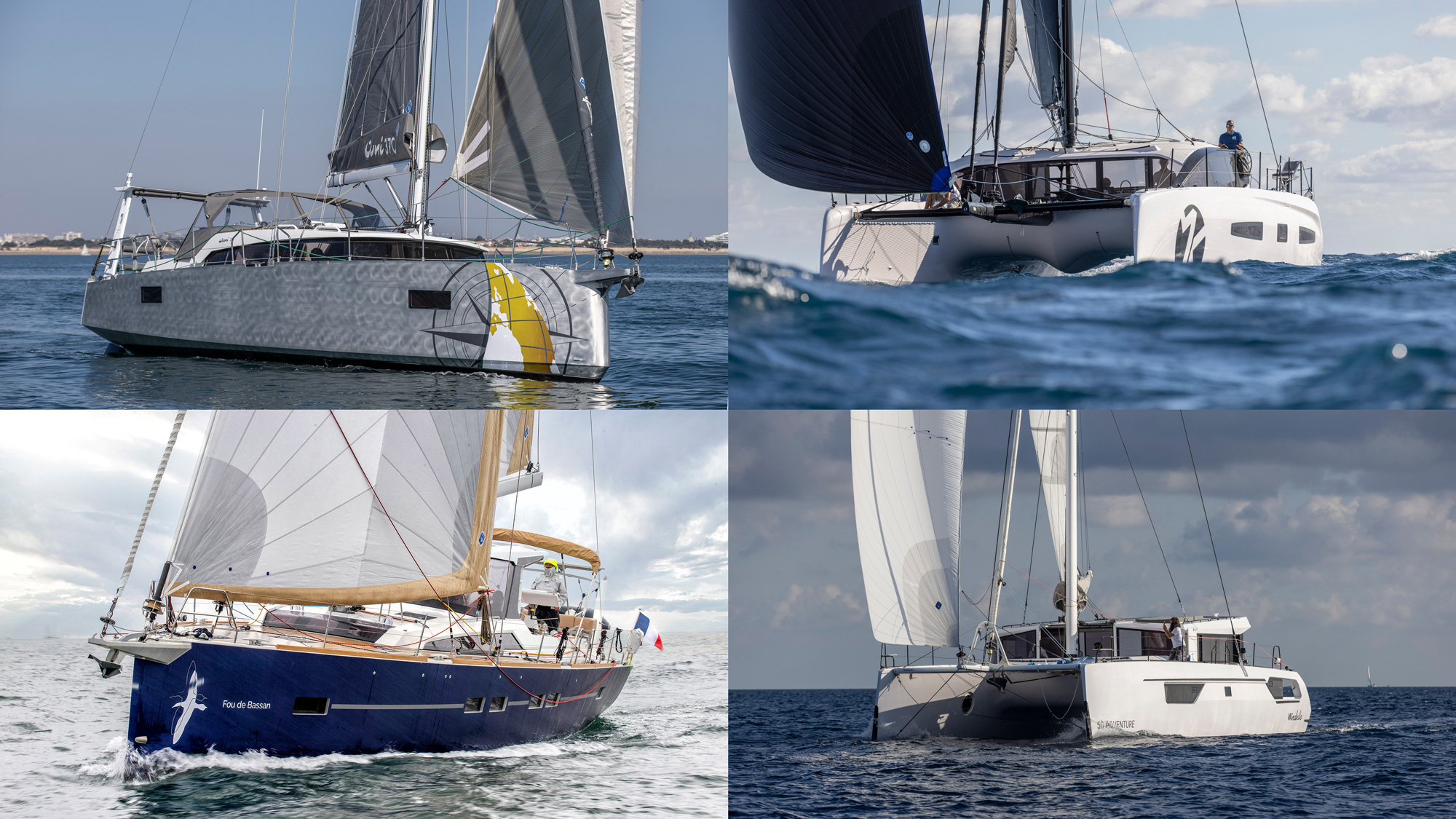
43 of the best bluewater sailboat designs of all time
Which yacht is the best for bluewater boating? This question generates even more debate among sailors than questions about what’s…
The optional free-flying working jib can be hoisted furled, so there’s no inner forestay to get in the way when tacking the genoa when it’s not set up.
If I was specifying the sailplan I’d also opt for a Code 0 for use when reaching with the apparent wind well forward of the beam, plus a large asymmetric shaped for deeper downwind angles than the test boat’s all-purpose sail. This would maximise downwind VMG in light and moderate airs.
Technical heart
An unusual, but appealing, feature of all Neel trimarans is the technical area below the saloon floor in the central hull – on some of the larger models this has an impressive 7ft (2.1m) of headroom, which makes for easy access and fault-finding. However the Neel 43 is smaller, which means this is reduced to generous sitting headroom and floor space is limited.
The central section houses tanks, plumbing and batteries, while the engine and steering gear are further aft. Further forward the space is dominated by a large number of electrical items and connections for solar charge regulators, shorepower battery chargers, inverters and so on.

The saloon opens almost seamlessly onto the cockpit. Photo: by Olivier Blanchet
It’s great that these are easy to access, which also serves as a reminder of the vast number of systems that are often hidden out of sight and distributed around different parts of today’s increasingly complex yachts.
However, there’s a downside that can’t be overlooked. These systems are low down in the boat, close to where any water will collect. Fitting a couple of bilge alarms, and making regular checks when underway by lifting the access hatch in the saloon floor, would therefore be sensible precautions. Despite this drawback it’s still an arrangement that has advantages over many installations.
Loft-style minimalism
What about the interior of the Neel 43? Despite the design’s abilities under sail, in this part of the market it’s the accommodation that sells boats. Yet, once again, this is an aspect that defies comparison with others.

Both transoms have swim platforms. Photo: by Olivier Blanchet
The almost seamless blending of indoor and outdoor areas is appealing, but far from unique among today’s multihull designs.
On the other hand, Neel has gone for the ultimate in a loft-style layout that’s refreshingly different. Masses of windows and large expanses of white fibreglass are balanced by just enough fabric and wood trim to give it some warmth.
Reed-style flooring also adds to a feeling of comfort, in the Neel 43 without increasing weight, and can be taken outside to wash and clean.
There’s excellent near-surround visibility – around 300° – when sitting in the saloon and it’s almost as good when standing.
Forward to port is a watchkeeping station with switch panel, and on our test boat a second MFD, VHF and Fusion audio kit, plus 12V outlets and an analogue steering compass here. However, it stops short of being a full chart table that could also be used as an office, so I’m typing this at the saloon table, which is a great place to work, with brilliant views and lots of natural light.

The saloon and galley area has a very open plan layout. Photo: by Olivier Blanchet
In common with other Neel models, the owner’s cabin is on the same level as the saloon. A downside is therefore a lack of privacy, even with the curtains drawn and door closed. However, it’s a beautifully lit and airy space that would suit those who primarily cruise as a couple.
There’s almost no built-in stowage, although the deep bins in the ama outboard of the bunk will take several large kit bags.
Neat touches for every bunk include a reading lamp with built-in USB port, a folding coat hook for jackets, plus a fabric bulkhead-mounted pouch with space for a phone, tablet, sunglasses, notebook and so on.
These may sound like small points, but it’s surprising how many boats lack provision for these items and they therefore quickly get scattered everywhere.
Natural ventilation is primarily via an opening forward facing window on each side of the coachroof – one for the saloon and one for the owner’s cabin.

A berth is separated by the red curtain. Photo: by Olivier Blanchet
There’s also a small opening hatch in the middle of the coachroof and another for the heads. This is a long, narrow compartment off the starboard side of the saloon.
Overall there’s plenty of space and a shower is included, though it’s not luxurious and there’s no option for a second toilet and shower compartment.
The second cabin is right forward in the central hull, accessed by steps just ahead of the galley. This is a pleasant space with more privacy than the owner’s cabin, though the berth is only 77cm wide at its foot.
A third sleeping area is outboard of the saloon table, aft on the port side of the saloon. This is open plan to the saloon, with curtains for screening, with a generous 140x200cm rectangular bunk with space underneath for kit bags. It would make a great space for kids on passage.

Bright accommodation in the owners cabin with views. Photo: by Olivier Blanchet
For the charter market there’s also an option to drop the saloon table to create an additional double berth, plus small single cabins forward in the amas that are accessed from the foredeck, making a potential maximum of 10 berths.
Few owners are likely to want to sail with that many for long, but the flexibility of being able to cater for extra short term guests, without dragging the weight and volume of spare bedrooms around the rest of the time has an obvious appeal.

Engine is housed in the central hull, with tanks further forward. Photo: by Olivier Blanchet
Given the price of the Neel 43 compared to other multihulls of a similar length it should not be a surprise that it has been conceived to be quick and easy to build, aside from the vacuum infused mouldings that are an important element in keeping weight to a minimum.
Those who love traditional joinery with hand crafted solid hardwood trim will be disappointed and the lack of a second heads will rule the boat out for some.
However, in general the relatively Spartan level of fit out Neel has opted for is appropriate for a boat of this style that’s aimed at a mass audience.
It took Neel 10 years to build its first 100 boats. In the current financial year, ending September, the yard has produced more than 30 boats across a four model range of 43-65ft sailing designs, plus semi-custom fuel efficient power trimarans.
The popularity of the Neel 43 means output is set to grow by a large margin in the coming year.
If you enjoyed this….
Yachting World is the world’s leading magazine for bluewater cruisers and offshore sailors. Every month we have inspirational adventures and practical features to help you realise your sailing dreams. Build your knowledge with a subscription delivered to your door. See our latest offers and save at least 30% off the cover price.
There’s much to like about this design: it’s a cruising boat in every respect, not an outright speed machine, yet it’s one that will quickly leave the competition behind. While it’s not a model that will suit everyone, founder Eric Bruneel has a good understanding of how a vast proportion of owners use their vessels and has created a yacht that will exceed their expectations in many respects. A decade ago trimarans were a niche part of the cruising world, however, the Neel 43 shows the concept of a cruising tri is ready for the mass market. The design has already proved hugely popular and one boat is leaving the factory every fortnight.

IMAGES
VIDEO
COMMENTS
Gunboat 68 (+35Kts) Gunboat 68 is a cruising catamaran designed to reach the highest speeds possible. Made by Gunboat, the ship uses Grand-Prix racing boats' designs to develop the speediest cruising catamaran on the market. Gunboat 68 is made entirely from carbon composites, which keeps the ship lightweight and fast.
Historically, however, Catana has made many beautiful boats. Notably, the 471 is a fast cruising catamaran that is a favorite among long-distance cruisers. On the smaller side, the 431 and even the 401 and 381 are quick and fun sailers that move better than their competition.
HH Catamarans has been turning heads since 2012 with a line of sporty, high-tech boats that feature a luxury fit-out. What started off on the drawing board as a fast 48ft cruising cat has grown to ...
These are the top five fastest cruising catamarans of 2020 according to us. Other impressive cruising multihulls include the Dolphin 42, Privilege 435, Fountaine Pajot Belize 43, Nautitech 44, Lagoon 440, Voyage 44, Outremer 45, Prout 45, and Leopard 45. Explore their features and more catamaran characteristics, keeping also a full record and ...
There's a balance within a boat that really performs that you can still live aboard.". A winning balance, it turns out, with the Balance 482 securing its position as the Best Performance Cruiser for 2022. With a powerful, versatile sail plan—as well as light, solid construction and go-fast daggerboards—the Balance 482 is a go-anywhere ...
Gemini 105M Courtesy of Gemini Catamarans. Pioneering catamaran sailor, builder and designer Tony Smith launched the first of his 33-foot Gemini 105M's (10.5 meters = 33′) in 1993, and soon after found a ready and willing stream of sailors enamored of the boat's compact size, affordable price tag, and such innovations as the nifty lifting rudder and transom steps.
The Fastest Cruising Catamarans Currently on the Market. The world of luxurious and high-performance catamarans is probably mostly dominated by Gunboat and HH Catamarans leading the way. Gunboat's 68ft, 72ft, and 80ft models excel with speeds over 30 knots, thanks to cutting-edge materials and construction techniques.
The Reichel Pugh design sits in a similar market to the Outremer 51 - a fast composite cruiser, aimed at couples going long-distance cruising. The first six 1600s sold off plans and Seawind ...
The HH66-SC integrates the very latest in race boat technology and is quite possibly the world's fastest performance cruising catamaran. This "no-compromise" boat features full carbon construction, dual helms, C-shaped carbon daggerboards, stunning performance and an unmatched level of customization.
Fast cruising is the theme this year, say Toby Hodges and Sam Fortescue, who look at some of 2021's exciting new multihull launches ... 2021 looks set to be a bumper year for new catamarans as the ...
Marsaudon Composite's new ORC57 may be the fastest, most powerful cruising cat ever. Toby Hodges tours the first model at its 2022 boat show debut Become a ...
Still, word spread: catamarans were lightning fast and sailed flat. They also offered other advantages compared to monohulls, like a lot of deck space. Unfortunately, popular opinion exerted its usual pressure on owners, designers and builders, and high-performance cruising catamarans were back-burnered until the 1960s.
August 30, 2022. Catamarans are known for their speed, and some vessels are fast enough to break world sailing speed records. Catamarans can go between 15 and 30 knots, with the fastest achieving speeds well in excess of 60 knots. Sailing catamarans are sometimes twice as fast as monohulls and cut through the water with greater efficiency.
At one point in 2013, France's Francis Joyon—a man renowned for his modesty and almost superhuman endurance—held the records for the fastest solo circumnavigation (57 days, 13 hours), the fastest solo 24-hour run (666.2 miles) and the fastest solo transatlantic (5 days, 2 hours). Since then the 24-hour record has fallen, but that in no ...
Toby Hodges takes a close look at this muscular racer-cruiser. A sign that brags 'the fastest cruising 40-footer in the world' is a sure-fire way to attract attention. My first impressions of ...
Some of the fastest cruising sailboats include the Beneteau Oceanis 30.1, which can travel at 20 knots; the Grand Soleil 34, which touches 20 knots; and the Italia 9.98, which can reach up to 40 knots. Of course, there are many other high-speed cruising sailboats that you can choose from. If you love to cruise but still want to reach your ...
Plenty of ideas here from a new French brand building speedy spacious catamarans from volcanic rocks and plastic bottles. Toby Hodges sails the first to laun...
Sailing catamarans come in all different shapes and sizes. Some are optimized for living space and comfort, while others are designed with fast cruising speeds being the sole goal of the boat. The Gunboat 68, one of the fastest cruising sailboats currently made, can exceed 30 knots. The world of power cats is much the same.
Lagoon 380. The long-time best-seller from the world leader in catamarans, with more than 1,000 produced over almost 20 years from 1999. With its characteristic vertical windows, the 380 and its ...
A list of 10 older cruising catamarans that offer good value and liveaboard comfort including models from Leopard, Catana, Lagoon, Privilege and more. ... The boat was meant to be a fast, strong bluewater voyager—and it was. The 43 was made with foam core, keeping the structure light, and it was very strongly built, with a powerful rig. ...
The Neel 43 has the deck space and massive coachroof of the most spacious of cruising catamarans, yet is at least three tonnes lighter than most 42ft cats. We we tested the Neel 43 in La Rochelle ...
Others say 6.3 knots. Chat gpt says most sailing catamarans cruise at speeds of 9-14 knots. So I'm just a bit confused and would appreciate some education. ... that pressure is what comes up through any hole in (any) boat. Boats sink fast. Moving forward, catamarans are fast, because they are relatively light. I've read on (2) occasions, that ...